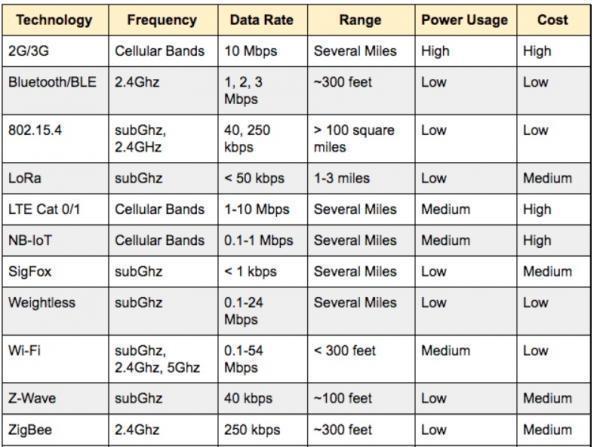Basic Guide to IoT Wireless Protocol Standards & Comparison

With the explosion of Internet of Things (IoT), many wireless standards are becoming available with many different applications. Here we list and compare some of the main legacy and new protocols that are shaping our technology landscape today:
2G
This is your traditional 2nd generation cellular network. Because of the low data rate, the user is only able to send simple text & images.
3G
This is the 3rd generation cellular network. The data rate is greatly improved, allowing images and internet surfing at a much faster pace than previous generation.
4G
This is the 4th generation cellular network that is very common in major cities across the world today. The faster data transmission allows for video calling, faster web browsing and watching online movies.
5G
This is the newest 5th generation cellular network that is already being deployed in various US, EU and Chinese cities. The high data rate makes downloading video
The breakthrough technology could potentially transform many industries with new applications. Connected cars, augmented reality, remote surgery and virtual reality could all be the new areas of future development because of this new 5G network.
Wi-Fi
This is a standard radio network that is used in households or stores. This Internet protocol network can transfer large amounts of data but with high power consumption. Thus, the Wi-Fi device needs to have steady power supply to support it.
Bluetooth BLE
BLE is also known as Bluetooth low energy. This is a short-range wireless standard that is commonly used in phones, computers, wearables, etc. It has a decent data transmission rate that is suitable for sending music & videos. The newest version Bluetooth 5.2 has low power consumption with longer range than its predecessors.
Zigbee
This is a recent wireless technology that is commonly used in smart home devices. It has an open distance range of 300-1000m and a decent data rate.
Z-wave
This is another wireless technology that is commonly used in smart home & electronic devices. It has an open distance range of 300-1000m and a decent data rate.
LoRa
This is a type of LPWAN, or low power wide area network. It has excellent downlink capability, but the uplink is not as great. It sends small data packets frequently, which is ideal for frequent but not vital information.
NB-IoT
This new long range wireless protocol is similar to cellular protocol. The network works on narrow band and has low power consumption, which is suitable for city-wide deployment. It sends small data bits at an interval but can handle a bit more data than LoRa or SigFox counterparts. The signals can also penetrate the through urban areas a lot better with faster response time.
SigFox
Another long range wireless communication protocol that is only ideal for uplink signal transfer. It has very low cost & low power but with limited capability.
Weightless
This is an emerging wireless technology that is very promising in nature. The protocol is long range LWPAN which can work Sub-GHz with high data rate. The costs can be lower or higher depending on the system complexity and number of node deployment.
For more information on how our alarms & detectors can implement wireless technologies, please contact one of our product specialists for more information.

